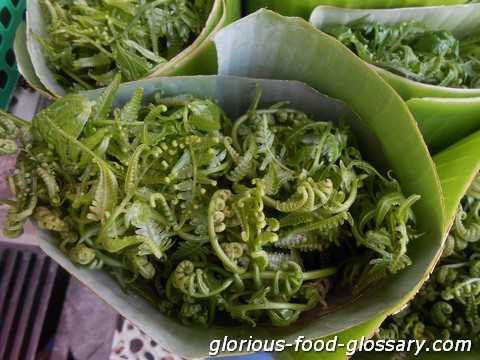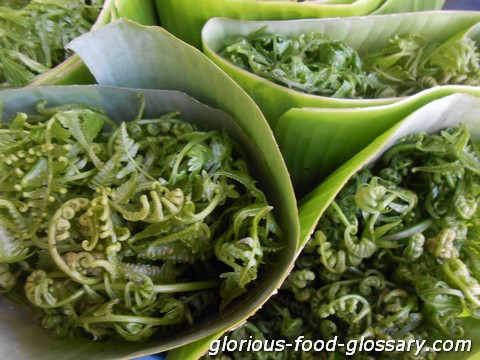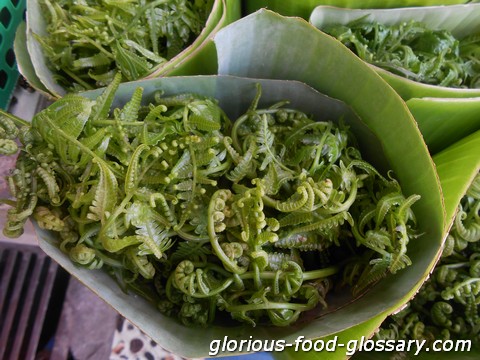English: Pako / Deutsch: Pako / Español: Pako / Português: Pako / Français: Pako / Italiano: Pako /
Pako, also known as fiddlehead fern, is a unique and nutritious vegetable that has gained popularity in various cuisines worldwide. In this article, we will delve into the definition, culinary applications, potential risks, and provide a delicious recipe for Adobong Pako. Additionally, we'll touch upon the history and legal aspects of Pako and list some similar vegetables.
Definition and Culinary Significance: Pako refers to the young, tightly coiled fronds of certain ferns, primarily the ostrich fern (Matteuccia struthiopteris) and the bracken fern (Pteridium aquilinum). These edible fern shoots are renowned for their unique shape and earthy, nutty flavor. Pako is a delicacy in many Asian and European cuisines and is highly regarded for its nutritional value.
Culinary Uses and Popular Recipe: One of the most beloved Filipino dishes featuring Pako is Adobong Pako, a flavorful and nutritious stir-fry. Here's a simple recipe to prepare this delicious dish:



Recipe: Adobong Pako
Ingredients:
- 2 cups fresh Pako shoots, cleaned and trimmed
- 2 cloves garlic, minced
- 1 small onion, chopped
- 2 tablespoons cooking oil
- 1/4 cup vinegar
- 1/4 cup soy sauce
- 1 teaspoon sugar
- Salt and pepper to taste
- Heat the cooking oil in a pan over medium heat. Sauté the minced garlic and chopped onion until fragrant and translucent.
- Add the cleaned Pako shoots to the pan and stir-fry for 2-3 minutes until they begin to wilt.
- In a small bowl, mix the vinegar, soy sauce, sugar, salt, and pepper. Pour this mixture over the Pako shoots in the pan.
- Continue to cook for another 2-3 minutes until the Pako is tender and has absorbed the flavors of the sauce.
- Remove from heat and transfer the Adobong Pako to a serving dish.
- Serve hot as a side dish or as a main course with steamed rice.
Nutrition and Health Benefits: Pako is a nutritious vegetable, rich in vitamins, minerals, and dietary fiber. It is a good source of vitamins A and C, iron, potassium, and folate. Consuming Pako may support eye health, boost the immune system, and aid in digestion.
Risks and Considerations: While Pako is generally safe to eat, it should be cooked before consumption to eliminate any potential toxins. Raw ferns may contain compounds that can be harmful if consumed in large quantities. It's also important to ensure that Pako is sourced from clean and uncontaminated environments.
Historical and Legal Context: Pako has been consumed for centuries in various parts of the world. It has historical significance in the cuisines of Asia and Europe, where it is often foraged from the wild. In some regions, there may be regulations regarding the harvesting and sale of wild ferns to ensure food safety.
Similar Vegetables:
- Asparagus: Known for its tender shoots and mild, earthy flavor, asparagus is a popular vegetable in many dishes.
- Broccolini: This vegetable is a hybrid of broccoli and Chinese kale, featuring slender stems and small florets.
- Rapini (Broccoli Rabe): Rapini is a bitter green vegetable with a broccoli-like appearance, often used in Italian cuisine.
Summary
Pako, or fiddlehead fern, is a unique and nutritious vegetable that has earned a special place in global cuisines. Whether enjoyed in Filipino Adobong Pako or other culinary creations, Pako's earthy flavor and nutritional value make it a versatile and healthy ingredient. Understanding its culinary significance, nutritional benefits, and safety considerations ensures that Pako can be savored as a delectable and wholesome addition to various dishes.Related Articles to the term 'Pako' | |
| 'Kakanin' | ■■■■■■■■ |
| Kakanin is a Filipino term used to refer to a wide variety of traditional Filipino rice cakes. These . . . Read More | |
| 'Saging na Saba (Hilaw)' | ■■■■■■■■ |
| Saging na Saba (Hilaw) refers to the unripe, green version of the Saba banana, a type of cooking banana . . . Read More | |
| 'Camote' | ■■■■■■■■ |
| Camote, also known as sweet potato, is a versatile and nutritious root vegetable that plays a significant . . . Read More | |
| 'Chamnamul / Cham Namul' | ■■■■■■■■ |
| Chamnamul / Cham Namul refers to a wild leafy green with a strong scent, blanched or served fresh with . . . Read More | |
| 'Dried Alamang' | ■■■■■■■■ |
| Dried Alamang in the food context refers to tiny, dried shrimp that are a staple ingredient in many Southeast . . . Read More | |
| 'Squid Balls' | ■■■■■■■■ |
| Squid Balls are a popular street food and culinary ingredient in various Asian cuisines, including Chinese, . . . Read More | |
| 'Wurzelgemüse' | ■■■■■■■ |
| Wurzelgemüse is the German term for root vegetables, which refers to edible plants that grow underground. . . . Read More | |
| 'Kamias' | ■■■■■■■ |
| Kamias is a Filipino fruit with scientific name Averrhoa bilimbi. The fruit is green and edible, about . . . Read More | |
| 'Huile de Sesame' | ■■■■■■■ |
| Huile de Sesame is the French term for \"Sesame Oil\" Sesame oil is of vegetable origin and is obtained . . . Read More | |
| 'Alugbati / Alogbati' | ■■■■■■■ |
| Alugbati / Alogbati: Alugbati called in English as Malabar spinach refers to a red-stemmed vine that . . . Read More | |
